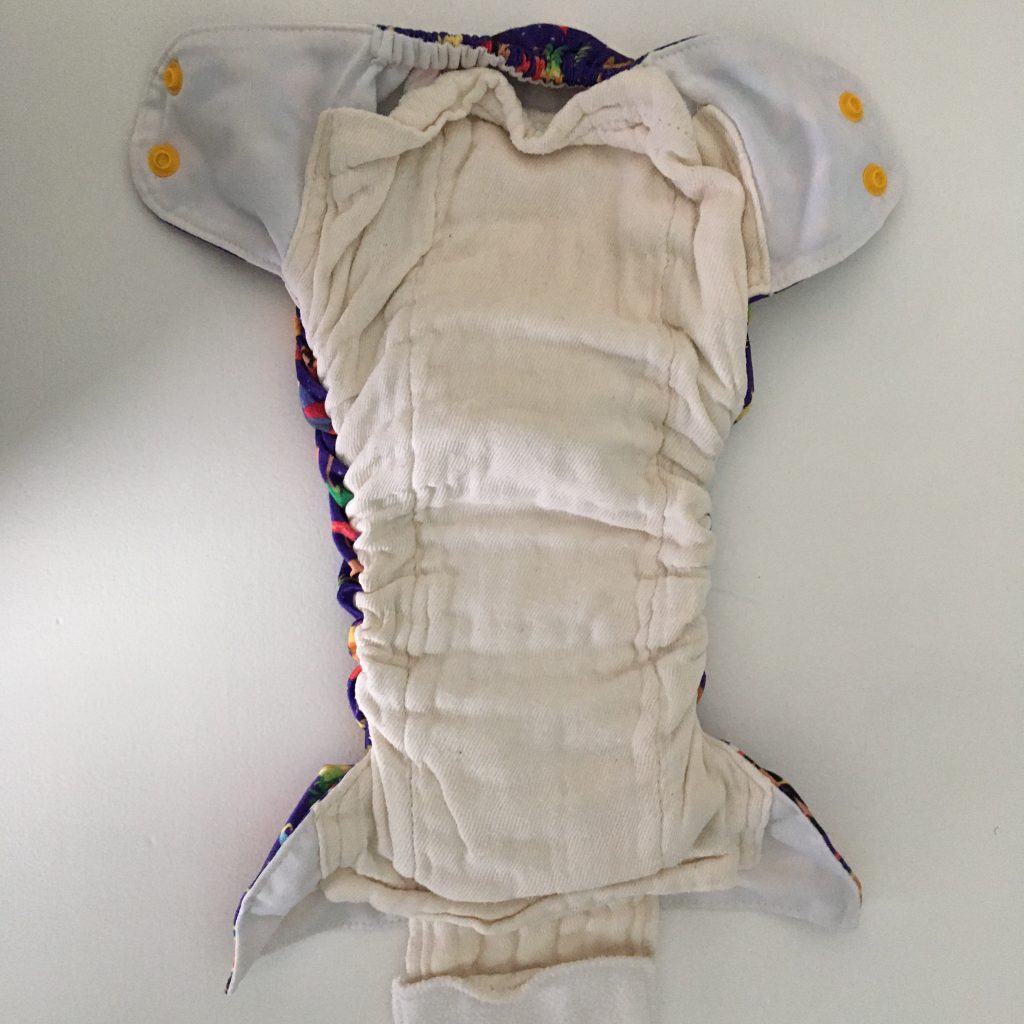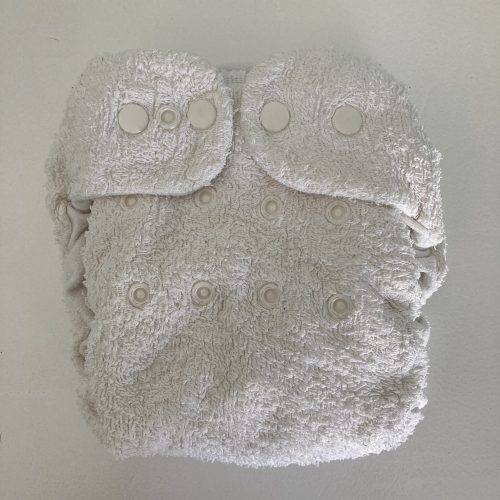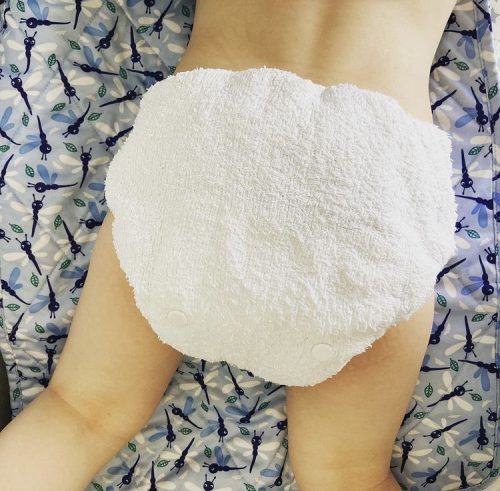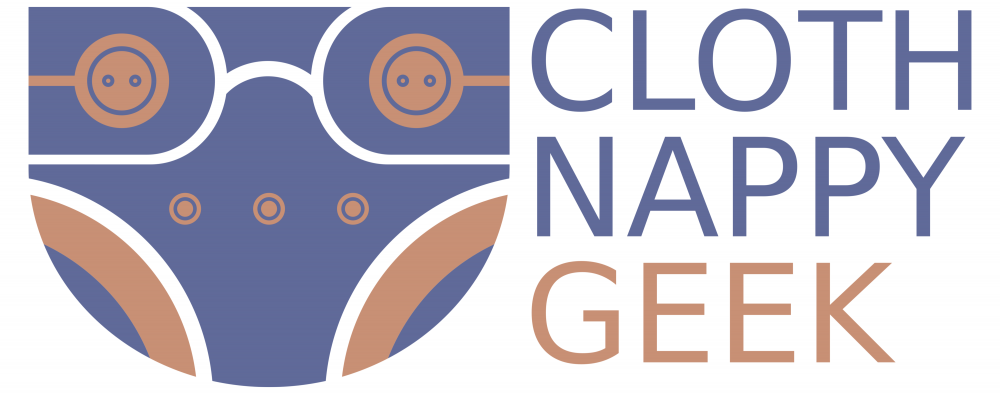Cotton is easy to care for. For boosters or anything without elastics/PUL you can wash at higher temperatures, tumble dry, or place directly against heat sources. Those in hard-water areas will find it goes crispy after multiple washes. It will instantly soften once your baby wets the nappy, but if this bothers you then you can shake the nappy or rub it against itself once dry to soften it up. Due to the natural oils it will require multiple washes to bring it up to full absorbency, up 10 washes in some cases.
It is the fastest absorber, you only need to try clear up some spilt water to see just how readily and easily cotton absorbs. This makes it perfect for flooding. It can also hold 27 times it’s own weight in fluid.
Available in a range of different weaves (such as Birdseye, Terry towelling, muslin, or waffle) and weights to offer different thicknesses. It can suffer from wear and tear, especially on edges of fabric (edgewear) where more friction will occur. Depending on weave and design of nappy they may not last more than one child. Bobbling is common too on flat weaves, although this tends to be more of a cosmetic issue.
Its very intensive to produce. Cotton cultivation accounts for 16.5% of global pesticide usage, and yet is only grown on 2.4% of arable land. Organic cotton is produced using less pesticides (some natural and synthetic pesticides are still used but in moderate quantities). But the lower yield quantities means organic cotton requires significantly more water. Opt for unbleached versions where available, and if you can afford to. These lessen the environmental impact.
Overall I think cotton is very underrated from an absorbency perspective, although predominantly cotton nappies may not last for multiple babies due to wear and tear.
🟢 A natural, plant-based, fibre that has a more affordable price tag. Biodegradable (if 100% natural) and breathable.
🟢 Highly absorbent and a very fast absorber. Can hold up to 27 times its own weight in fluid.
🟢 Widely available and comes in a huge range of weaves and weights. Easy to purchase ‘non nappy’ items such as flannels to be cheaper (but very effective) boosters. Plus many homes are likely to have cotton items that can be repurposed into boosters.
🟢 Available in organic and unbleached versions, although this starts to increase the price.
🔴 It’s a ‘dirty’, resource intensive, crop. Cotton cultivation accounts for 4.7% of the world’s pesticide use and 10% of insecticides, yet is only grown on 2.4% of arable land. Pesticide poisoning is not uncommon for farmers, their families, and communities. Profit margins for farmers, especially smallholders, are tiny due to the need for, and cost of, pesticides.
🔴 Cotton requires huge amounts of water. 2,700 litres to create a single t-shirt. That’s 3 years of drinking water for a human. This diverts water away from agricultural for food.
🔴 This excessive watering damages the soil meaning other crops will fail to thrive.



Organic vs non-organic cotton
In short organic cotton is more environmentally friendly, but it I not the answer to global warming. Overconsumption is a huge issue and organic materials are not the solution.
But let’s get into the differences.
Organic cotton looks different. When new (unwashed) it will have a creamy colour because it hasn’t been bleached. But even after the hundreds of washes it is still more creamy. You may also spot little flecks in the fabric, although these will wash out in time.
Organic cotton is more sustainable. No dangerous pesticides is a huge winner, to the farmers, communities and wildlife.
But the yields are lower. Which is why it’s more expensive, despite the lack of expensive pesticides. And there’s the classic supply and demand, there just isn’t enough organic cotton being produced for the markets. Pushing up prices and pushing down availability. Lower yields also mens more land is needed, so more clearance of natural habitat.
And then there’s accreditation. If you’re paying organic prices then ensure that it has been certified by a reputable organisation (think GOTS although there are others).
I do believe organic cotton is the way forward but it’s unfeasible at our current rate of textile consumption.
Cotton Terry
You’ve almost certainly got some cotton terry items in your home. It’s commonly used for bath towels and flannels (which can be repurposed into boosters if needed).
It’s the loops that make terry so good. And in the case of this nappy Easy Peasy Bumble it is a long loop.

The loops mean you have more surface area, and therefore more absorbency.
They also absorb extremely quickly. I think the quickest of all fabrics (and yes I’m including microfibre in that). Having a raised surface prevents run-off as well which can be a problem with flooders.
Terry is a thick, sturdy material (or it should be if it’s of decent quality). Built to last. It can be a little bulky compared to smooth fabrics.
Eventually with friction, washing, and general use the loops will wear down. But it’s not uncommon to see people with terry squares that are decades old (🙋♀️), or bathroom towels that have been used daily for several years (🙋♀️).
Do you have any cotton terry nappies? What do you think of them? This cotton terry Bumble was actually the first nappy I ever purchased, and I still use them daily 4 years later.
Muslin
Most people, or parents of babies at least, will have muslin items already. Muslins are commonly used as burp cloths for young babies. The muslin used for nappies is essentially the exact same, but it’s a heavier weight, meaning it is more absorbent. That said I’m a huge fan of using what you have, and the burp cloth muslins can make great boosters. Or you can lay two together to give you more absorbency.
The name muslin refers to the weave, therefore it is possible to get other fibres in muslin. Cotton:viscose or cotton:polyester are also common. But we’re specifically looking at cotton muslin here. For nappies you really want 100% cotton and not a blend with a man-made fibre.
Muslin weave uses a fine thread and there is space between the fibres. This makes it lightweight, breathable and soft.
It has a high number of threads which in turn gives it good levels of absorbency. And we already know that cotton is highly absorbent. Because it is so lightweight it dries very fast.
It is prone to shrinkage, especially if dried on a high heat. It also creases easily due to the loose weave, but this isn’t really a consideration for nappies. Although cotton generally is good at wicking, muslin is poorer at it than other weaves. This means wetness is less likely to evenly distribute throughout the fabric so dryer patches away from your baby’s wet zone are common,
Muslins make an excellent newborn nappy, but can be used on older children too. Padfolding into a wrap, or using as a pocket nappy insert.
Well suited to warmer climes due to its breathability, but also great in winter because it dries so quickly.
Cotton jersey
Jersey cotton is a newer fabric to the cloth nappy world. Simply because before preflats rose in popularity it didn’t really have a place.
Like all cottons it is absorbent and breathable. And again you almost certainly already have this fabric in your home as it is most commonly used in clothing.
Jersey is soft and flexible. Even in hard water areas. It also has a bit of stretch which is why it is so well suited to preflats.
But don’t let that put you off using jersey cotton as a general insert. It works great padfolded into a wrap, or stuffed into a pocket. And it’s a great way to use old t-shirts etc.
It can be prone to shrinkage, especially if tumble dried on hot. So best to air dry.
Like for like (GSM is important here), jersey cotton is more absorbent than muslin, but less absorbent than terry.
